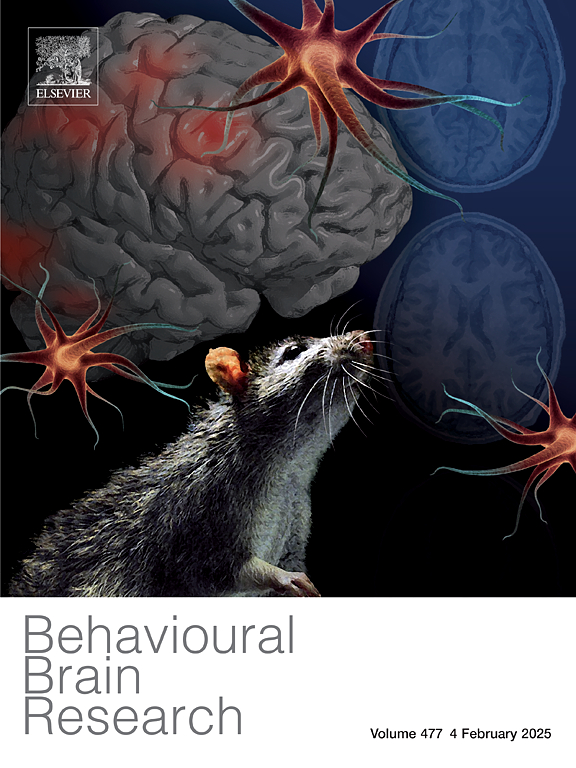Comparative brain proteome analysis of an Indole Alkaloid of Kratom, Mitragynine and Kratom juice in rats
IF 2.6
3区 心理学
Q2 BEHAVIORAL SCIENCES
引用次数: 0
Abstract
Mitragyna speciosa, commonly known as kratom, is a medicinal plant that is widely used for various medical conditions. The major alkaloid in kratom is mitragynine which binds partially to opioid receptors to produce opioid-like effects. In this study, we compared the effects of mitragynine various doses with kratom juice on neurobehavioral, neurochemical changes as well as calretinin protein expression. Sprague-Dawley rats were divided into ten groups (n = 6) and respectively received the following treatment: group 1 (20 % Tween 80), group 2 (morphine 10 mg/kg), groups 3–9, mitragynine graded doses (0.25, 0.5, 1, 5, 10, 15, and 30 mg/kg) and group 10 was given kratom juice (500 mg/kg). All the treatments were given as a single dosing and then for four consecutive days. On day 5, an open field test box was used for the assessment of behavioural parameters using global scoring. Whole brains were harvested and the effects of the treatments on some neurotransmitters related to addiction were determined using ELISA kits. Proteomic analysis was also conducted using two-dimensional gel electrophoresis and a western blot was conducted to determine the changes in the expression level of calretinin. Mitragynine but not kratom juice significantly increased some behavioural signs. Mitragynine doses above 5 mg/kg significantly increased dopamine, 5-HT, and GABA concentrations, whereas kratom juice only elevated GABA levels. Rat brain proteome analysis revealed that mitragynine significantly up-regulated calretinin. Western blot analysis shows that mitragynine but not kratom juice, significantly increased the expression level of calretinin. These findings suggest that kratom juice at the dose tested (500 mg/kg) may pose less risk of addiction compared to pure mitragynine at various doses.

苦参、米特拉金碱和苦参汁中吲哚类生物碱对大鼠脑蛋白质组学的比较分析
米特拉吉那,俗称克拉托姆,是一种药用植物,广泛用于各种医疗条件。苦参中的主要生物碱是米特拉金,它部分地与阿片受体结合,产生类似阿片的作用。在本研究中,我们比较了米特拉金不同剂量与克拉托姆汁对神经行为、神经化学变化以及calretinin蛋白表达的影响。将Sprague-Dawley大鼠分为10组(n = 6),分别给予1组(20 % Tween 80)、2组(吗啡10 mg/kg)、3-9组米特拉吉碱分级剂量(0.25、0.5、1、5、10、15、30 mg/kg)和10组克拉冬汁(500 mg/kg)。所有的治疗都是一次给药,然后连续四天。第5天,采用开放式现场测试箱,采用全局评分法评估行为参数。采集全脑,使用ELISA试剂盒测定治疗对一些与成瘾相关的神经递质的影响。采用二维凝胶电泳和western blot方法进行蛋白质组学分析,检测calretinin表达水平的变化。米特拉金碱而不是克拉通果汁显著增加了一些行为迹象。米特拉金剂量高于5 mg/kg显著增加多巴胺、5-羟色胺和GABA浓度,而克拉托姆汁仅提高GABA水平。大鼠脑蛋白质组分析显示,米特拉金显著上调calretinin。Western blot分析显示,米特拉金碱显著提高了calretinin的表达水平,而苦参汁则没有。这些发现表明,与不同剂量的纯米特拉吉宁相比,测试剂量(500 mg/kg)的克拉托姆汁可能造成的成瘾风险更小。
本文章由计算机程序翻译,如有差异,请以英文原文为准。
求助全文
约1分钟内获得全文
求助全文
来源期刊

Behavioural Brain Research
医学-行为科学
CiteScore
5.60
自引率
0.00%
发文量
383
审稿时长
61 days
期刊介绍:
Behavioural Brain Research is an international, interdisciplinary journal dedicated to the publication of articles in the field of behavioural neuroscience, broadly defined. Contributions from the entire range of disciplines that comprise the neurosciences, behavioural sciences or cognitive sciences are appropriate, as long as the goal is to delineate the neural mechanisms underlying behaviour. Thus, studies may range from neurophysiological, neuroanatomical, neurochemical or neuropharmacological analysis of brain-behaviour relations, including the use of molecular genetic or behavioural genetic approaches, to studies that involve the use of brain imaging techniques, to neuroethological studies. Reports of original research, of major methodological advances, or of novel conceptual approaches are all encouraged. The journal will also consider critical reviews on selected topics.
 求助内容:
求助内容: 应助结果提醒方式:
应助结果提醒方式:


